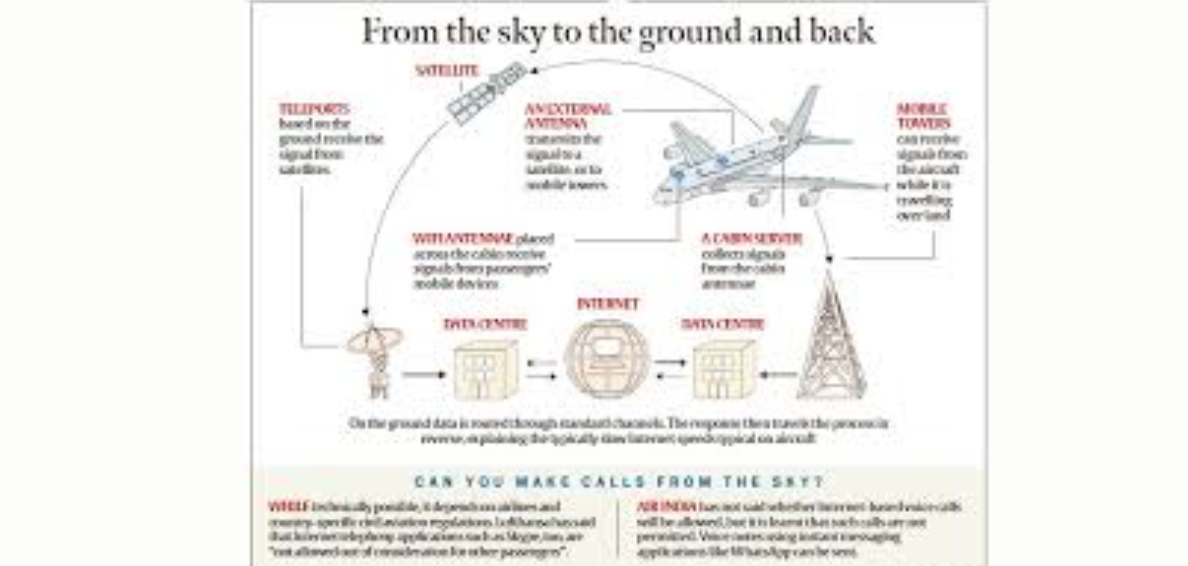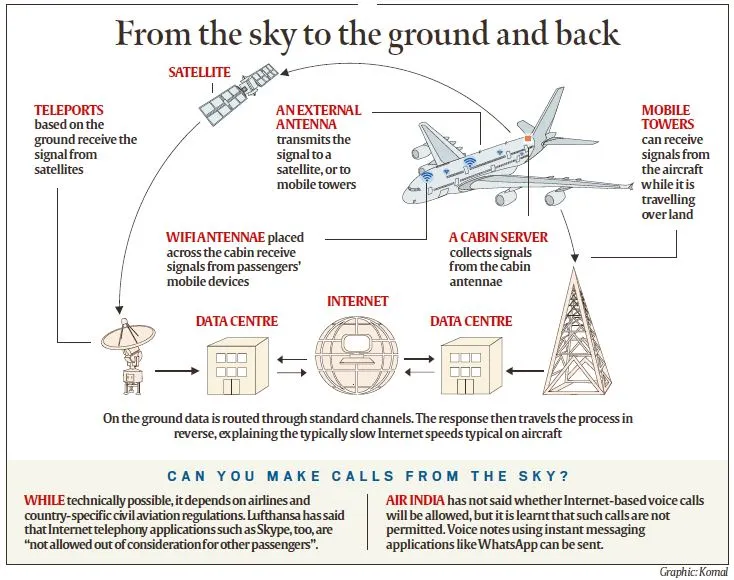- Courses
- GS Full Course 1 Year
- GS Full Course 2 Year
- GS Full Course 3 Year
- GS Full Course Till Selection
- Answer Alpha: Mains 2025 Mentorship
- MEP (Mains Enrichment Programme) Data, Facts
- Essay Target – 150+ Marks
- Online Program
- GS Recorded Course
- Polity
- Geography
- Economy
- Ancient, Medieval and Art & Culture AMAC
- Modern India, Post Independence & World History
- Environment
- Governance
- Science & Technology
- International Relations and Internal Security
- Disaster Management
- Ethics
- NCERT Current Affairs
- Indian Society and Social Issue
- NCERT- Science and Technology
- NCERT - Geography
- NCERT - Ancient History
- NCERT- World History
- NCERT Modern History
- CSAT
- 5 LAYERED ARJUNA Mentorship
- Public Administration Optional
- ABOUT US
- OUR TOPPERS
- TEST SERIES
- FREE STUDY MATERIAL
- VIDEOS
- CONTACT US
How In-Flight Internet Works: Explained
How In-Flight Internet Works: Explained
04-01-2025

In January 2025, Air India started the New Year by announcing the launch of Wi-Fi Internet connectivity on select domestic and international flights. This makes Air India the first airline in India to offer Wi-Fi on domestic flights.
- Free Wi-Fi on Domestic Flights: For a limited introductory period, passengers on select domestic flights operated by Air India will be able to use free Wi-Fi. Over time, the airline plans to offer the service on more aircraft.
- Global Trend: In-flight Internet services are becoming a standard feature on many major international airlines. Air India, after returning to the Tata Group three years ago, has big plans to become one of the top airlines in the world.
Which Air India Aircraft Currently Offer Wi-Fi?
Right now, Wi-Fi is available on the following aircraft in Air India's fleet:
- Airbus A350: Air India began operating this aircraft in 2024, and it has the needed equipment for in-flight internet connectivity.
- Boeing 787-9 and Airbus A321neo: These planes were previously operated by Vistara, which merged with Air India in November. Before the merger, Vistara already offered Wi-Fi on some international flights.
- Technology Provider: The in-flight Wi-Fi service on these aircraft is provided by Nelco (a Tata Group company) in partnership with Panasonic Avionics Corporation.
- This service was used by Vistara before the merger.
How to Connect to In-Flight Wi-Fi
Passengers can follow these steps to use the in-flight Wi-Fi:
- Turn on Wi-Fi on Your Device: Enable Wi-Fi and select the ‘Air India Wi-Fi’ network.
- Go to Air India’s Portal: After connecting to the network, passengers will be automatically redirected to the Air India portal using their device’s web browser.
- Enter Passenger Details: To connect, passengers must enter their PNR (Passenger Name Record) and last name on the portal.
- Once logged in, the device will be connected to the Wi-Fi.
Technologies Behind In-Flight Internet Connectivity

There are two main types of technology used for in-flight Internet: Air-to-Ground (ATG) and Satellite-based Connectivity.
1. Air-to-Ground (ATG) Technology
-
How It Works:
- An antenna on the aircraft’s belly picks up signals from cellular towers on the ground.
- This is similar to how mobile phones use the internet on the ground.
- As long as the plane flies over areas with enough towers, passengers will experience steady internet.
- Limitations: The connection can become unstable when the aircraft is flying over places with few or no towers, such as oceans or deserts.
2. Satellite-based Connectivity
-
How It Works:
- An antenna on top of the aircraft receives and sends signals to satellites in space.
- This method offers better coverage, especially when flying over areas without any ground-based towers, like oceans or remote land areas.
- The satellite sends signals between the aircraft and ground stations or teleports.
Signal Transmission Process (Same for both ATG and Satellite):
- Signals are sent from the passenger’s devices to the Wi-Fi antennas inside the cabin.
- The in-cabin antennas send the signals to an on-board server.
- For satellite-based systems, signals are sent through the antenna on top of the aircraft to the satellite and then to the ground station. The process is reversed for the response.
- For ATG technology, signals from the server on the aircraft are sent directly to cellular towers on the ground.
Note: In-flight Wi-Fi is usually slower than ground-based Internet, but newer technology is helping to improve speed.
Costs of In-Flight Wi-Fi: Airlines and Passengers
Initial Costs for Airlines
- Airlines must pay to install special antennae and other equipment on their aircraft.
- New Aircraft vs Retrofitting: Some airlines prefer installing Wi-Fi on new planes rather than retrofitting old planes, because retrofitting takes the aircraft out of service for a while.
- Air India’s Approach: Air India is currently installing Wi-Fi equipment on its newer aircraft, like the Airbus A350 and Boeing 787-9. The airline is also undergoing a $400 million retrofit of its older narrow-body fleet, which could include adding Wi-Fi equipment to these planes.
Pricing Models for Passengers
- Free Wi-Fi: Air India is offering free Wi-Fi for a limited introductory period on domestic flights.
- Future Charges: The airline has not announced when it will start charging for Wi-Fi, but as more passengers want in-flight Internet, airlines are starting to charge for the service to earn extra income.
Many airlines give a small amount of free data, and after that, passengers have to buy data packs. Some airlines give unlimited Wi-Fi to premium passengers (business/first-class) or loyalty program members. - Expected Trends: As demand for in-flight Wi-Fi grows, airlines will likely charge for the service, especially for economy class. Free Wi-Fi might only be available for premium passengers or loyalty program members.
Conclusion
Air India’s launch of in-flight Wi-Fi on select aircraft is an important step in making air travel more connected. With satellite and air-to-ground technologies, more aircraft will soon offer fast and reliable Internet for passengers. For now, Air India is offering the service for free, but passengers may need to pay for it in the future as airlines look for ways to make money from this growing demand.
|
Also Read |
|



